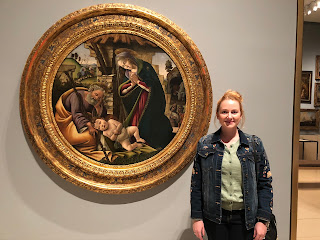I've needed many years, college classes, books, museum visits and art documentaries to navigate, differentiate, appreciate and understand many (and surely not all) of the different art movements out there. It can be very confusing. That's why I wanted to write a simple, introductory overview. Knowing art history basics is very important when you start collecting art and it helps judge and value artworks much better.
Preface: this is a very Eurocentric summary... In the West, universities and research tend to focus on ancient Greece & Rome, European Middle Ages, Renaissance, Baroque, and only in the 19th-20th centuries does it start getting more global. Mesoamerican, Asian, African, Mesopotamien (a.o.) art histories are neglected and overlooked. I'm aware of that big gap in knowledge but can't contribute to those continents / cultural heritages yet. Also, this will be about paintings only and leave out all the other art genres like sculpture, photography, installation etc.
While the first paintings appeared in caves between 40 and 32,000 (!!!) years ago, painting really started booming in the Middle Ages (6th-15th century). Back then, when Christianity ruled over every aspect of life, only Biblical depictions were allowed and art was made for and exhibited in the church exclusively, to cheer up and educate the masses, hence all those gorgeous altar retables we see in a lot of museums today.
 |
| Martín de Soria, 'Altarpiece of Saints Michael and Anthony Abbot', 15th century, Meadows Museum, Dallas |
Renaissance (~15th-16th century) is a movement where individuality becomes more important, science and literature gain interest, kings order artists to beautify their palaces, the nobility may even get their portrait painted. Biblical motives remain very important, though are now humanized. Greek and Roman mythologies get retold. Oil paint is invented and replaces tempera.
 |
| Lonardo da Vinci, 'Virgin of the Rocks', 1483-86, Louvre, Paris |
 |
| Sandro Boticelli, 'Adoration of Christ', 1495-1500, Museum of Fine Art, Houston |
Baroque (17th) and Rococo (18th century): there is a new social class in many European countries - wealthy, not aristocratic people. We'd call them bougie nowadays. The 5 painting types emerge - next to the renown history paintings (bible and ancient mythology) and portraits, there now are the genre (paintings of everyday people), landscape and still life. The three last ones are acquired by rich people for their homes. Art is still something exclusive and glamorous. While baroque art often teaches people to be more humble and to sin less, Rococo mostly depicts wealth and fun, though most people's reality is far from that.
 |
| Johannes Vermeer, 'The Milkmaid', 1657-58, Rijksmseum, Amsterdam |
 |
| Fragonard, 'The Swing', 1767, Wallace Collection, London |
19th century this is where art really starts to be very multi-facetted. There is realism - the desire to paint as close to real life as possible, like in the centuries before, but there is also a new attempt to emphasize a more subjective point of view. Why? Because of a changing world view, new technology, the industrial revolution, evolving social structures and shifting moral understandings, the possibility of traveling... Art is now less exclusive and is consumed by masses at exhibitions. It starts to depict suffering and poverty, erotism and excess. Impressionism is born, a reaction to photography; it's followed by Expressionism. Both push art away from realism, Abstract Art (non-figurative, not depicting life-like things) is born.
 |
| Edouard Manet, 'Nana', 1877, Hamburgische Kunsthalle, Hamburg. |
20th century is the century of 'isms'- it's impossible to name them all! The two World Wars, the radical technological advances make art extremely versatile - just like the experiences of the people creating it. We have Picasso's Cubism, Dali's Surrealism, Italian Futurism, American Abstract Expressionism, Pop and Op Art and many more that form what's called 'modern' art. Artists get inspired by mathematics, chemistry, geography, music, cinematography, psychoanalysis...
 |
| Juan Gris, 'Portrait of Picasso', 1912, Art Institute of Chicago |
 |
| Frida Kahlo, 'The Two Fridas', 1939, Museo de Arte Moderno, Mexico City |
21th century - our time, and our art, that's referred to as 'contemporary'. What is it? A return of older movements with the prefix Neo-: Neo-Pop Art, Neo-Impressionism, Neo-Surrealism. Photorealism to fool the eye. A continuation of abstract art (colors, shapes) right next to "conventional" realism. More environmental art. And as a new addition, digital art.
 |
| Gerhard Richter, 'Forest (5)', MoMA, NY |
 |
| John Currin, 'Hot Pants', 2010, The Broad, LA |
See... it's virtually impossible to create something completely new because so much has already been done. Artistic innovation usually lies in the appropriation of an old method by adding a subjective, exciting point of view. And that is what one has look for in today's art world.
What makes your favorite art special?
Talk to you soon,
J.









0 Comments